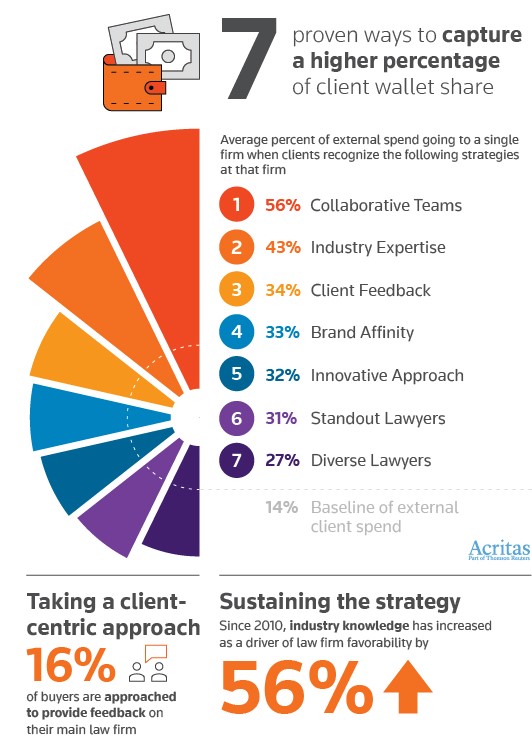In the new issue of Forum magazine, we see how an increased focus on clients has become even more critical to a law firm’s success & to gaining future work
All successful law firms have one thing in common: The client base acts as the beating heart and the driving force for change. And the good news for these firms is the typical global client rewards them by allocating the majority of its legal budget to external legal counsel.
Since March, however, an increased focus on clients has become even more critical to a firm’s success. Organizations’ legal budgets — even in the best-case scenarios — have come under increased scrutiny. In the worst cases, corporate law departments are expecting their legal spend to reduce significantly. In turn, law firms are experiencing similar cuts to their expenditures. For law firms, this poses two questions:
-
-
- How do we defend the share of our clients’ legal spend that we’ve received to date?
- How can we continue to grow our relationships with our existing clients?
-
Recent research from Thomson Reuters Acritas has identified which law firm strategies can prove most impactful in defending — or better still, growing — a firm’s share of client spending. Indeed, by comparing more than five years of client feedback ratings gathered from Sharplegal — a global study of senior legal buyers at the world’s largest organizations — against the close-to-client strategies that law firms of all shapes and sizes are focused on, Acritas has found seven clear focus areas which, when executed properly, will bring suitable return on investment.
These strategies are impactful regardless of whether your firm’s goal is to grow profit from existing clients, improve client retention levels or accelerate new client growth. Not only do these strategies benefit the bottom line of the client relationship, each one also links to increased client satisfaction and a client’s likelihood to recommend. The former links closely to client retention, while the latter is a strong indicator of a firm’s growth potential with both existing clients and new prospects.
The impact of these strategies is scientifically analyzed from the client’s perspective, and not the law firm’s intention in devising and executing these strategies. We looked at which firms buyers use, how much they spend on their outside firms and which strategies are visible in their experience with those firms. We then identified which attributes correlate with higher proportions of client spend.
Getting noticed by clients
If this is the impact when each strategy is recognized by clients, what can firms be doing to showcase each one more successfully? Having an innovative approach is a perfect case study for this.
While lawyers stand strong at the front line of the client relationship, law firm innovation teams — and, by virtue, the innovative solutions they create — often don’t get the same levels of exposure. In fact, though innovation in the legal industry has been a hot topic for the past few years,
that noise hasn’t translated into a noticeable market shift. Only 35% of corporate legal buyers say they work with any legal providers that demonstrate modern, innovative practices. And only 1 in 10 recognizes law firms specifically as that innovative provider.
Seven clear focus areas, when executed properly, will bring suitable return on investment.
When analyzing the law firms that are identified as innovative versus those that are not, the biggest difference is, not surprisingly, the lawyers. Firms whose lawyers are more comfortable and confident in understanding and conversing about the innovations their firms offer are more likely to open the door to conversations that allow the lawyers to further shine a light on the firm’s investments.

Empowering lawyers to talk about the firm’s strategies with their clients — whether it’s an increased focus on diversity or a new predictive analytics tool — is the first step in breaking down this barrier. Providing the right learning and development support for a firm’s lawyers to understand the benefits of each strategy for the client (not just for the firm), will help lawyers spot opportunities to showcase the investments the firm is making.
Taking a client-centric approach
Effectively exposing clients to these strategies is just the first hurdle. Another challenge sits in the age-old conundrum that every client is different. One tactic firms employ successfully (though not frequently enough), is directly asking clients to contribute to firms’ client feedback initiatives.
If innovation is important to your clients, then you should be asking them what they consider to be innovative and whether the firm is delivering against that expectation. What one client sees as a standout lawyer quality, may be a turnoff for the next, so firms should consider clients’ servicing preferences when building their account team. Further, law firms need to ask how they are able to understand and incorporate the nuances needed to adapt their brand messaging and make it resonate with different segments of the market.
The most successful strategies are built and reviewed in this way, with the voice of the client at their core.
Sustaining the strategy
In fact, constantly reviewing a strategy is essential when looking to preserve it in the long term. Of the seven strategies, one of the most intensive is building (and maintaining) industry sectors.
During the pandemic, clients have been extremely eager for more insight into what their peers are doing
and how regulations might affect their specific industry. Most law firms react well to this demand, with some creating industry teams overnight, while others use this opportunity to demonstrate why an industry focus is imperative in today’s legal world.
Regardless of the approach taken, maintaining this enthusiasm will be crucial for law firms as they look to protect their position against competitors. Firms should therefore align a goal to their strategy — whether it’s number of client feedback interviews completed or growth in a particular industry sector.
Deciding the right strategy to align with your law firm’s goal is crucial to its success.
Having something to aim for, and then setting key performance indicators to track performance against, means that whichever of the seven strategies your firm is focused on, clients will continue to appreciate the enhanced effort.
Final thoughts
Deciding the right strategy to align with your law firm’s goal is crucial to its success. Each lever has a different level of impact depending on whether your firm is looking to protect, grow or prosper from your current client base. It is no longer enough to simply say you are focused on each item: Clients want law firms who walk the walk and make the investments necessary for these strategies to succeed.
Ultimately, clients will spend their money with the firms that do exactly that.








